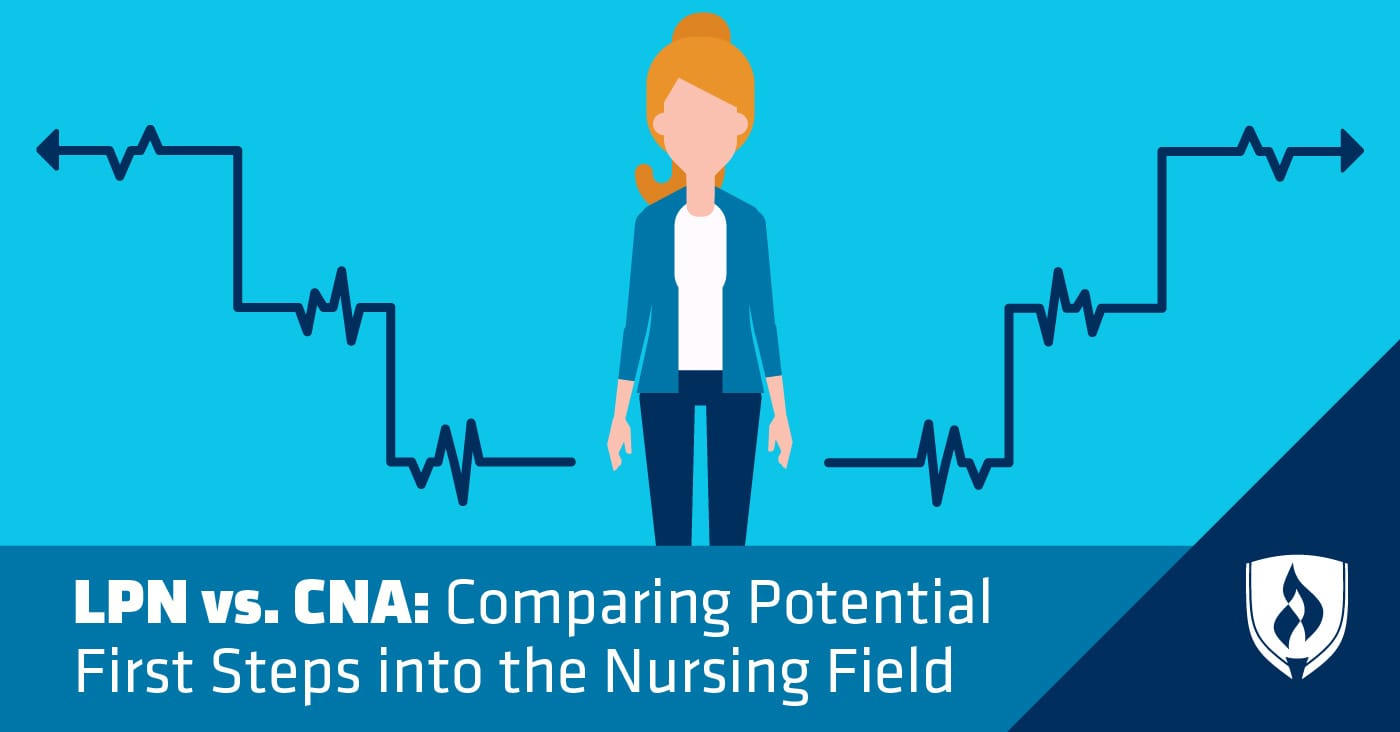
Choosing to enter the field of nursing is a significant step. You may know deep down that you want to help patients—but figuring out where to start seems complicated. There are so many credentials and types of nurses out there, and they all come with certain skill sets, education levels and job duties. With all the nursing profession’s degrees, specializations, paths and titles, it can be difficult trying to decide what you should do.
That’s why we’ve decided to start with two of the most accessible nursing-related careers. For those new to the field, both the certified nursing assistant (CNA) and licensed practical nurse (LPN) roles can be great ways to get your start caring for patients. Many nurses begin their careers as either and then go back to school to advance toward a registered nursing (RN) position.
While both roles can provide excellent starting points for a long healthcare career, there are several significant differences between LPNs and nursing assistants. If you’re curious to learn more about these differences, read on! This breakdown can help you decide which one is a better fit for you.
Get Your Nursing School Questions Answered at a Nursing Information Session
LPN vs. CNA: The basics
Before we get too far along in this comparison, we should clarify that we’re using “CNA” to broadly refer to all nursing assistants and nursing aides. Depending on the state you plan to work in, you can find nursing assistants with the designation of certified nursing assistant (CNA), registered nursing assistant (RNA), state tested and approved nursing assistant (STNA) and licensed nursing assistant (LNA)—these titles are responsible for duties that are largely similar.
With that out of the way, let’s take a look at the broad, overall duties of each position. Once you understand what you would be doing as a CNA or LPN, you can better decide which you would enjoy most.
What does a CNA do?
While both nursing assistants and LPNs work in healthcare, it’s important to note that CNAs are not truly nurses, but nursing assistants. Because of this, much of their day-to-day work involves basic care duties. Their scope of practice is rather small, and they usually work in conjunction with a team of healthcare professionals, such as nurses or physicians. Typical responsibilities can include taking vital signs, lifting and transporting patients, feeding patients and assisting with bathing and dressing. CNAs may also serve meals, help patients use the bathroom and transfer to wheelchairs. In some states, CNAs can also dispense medication.1
What does an LPN do?
LPNs are nurses who perform duties such as changing dressings, inserting catheters, keeping records of patients’ health, monitoring vital signs and will sometimes work in conjunction with registered nurses to help educate patients on certain medications and treatments. They also assist patients with tasks such as dressing, bathing and eating.
LPN vs CNA: Skills needed to succeed
We used real-time job analysis software to examine thousands of CNA and LPN job postings. Our findings revealed the most in-demand skills employers are seeking in each field.
In-demand LPN skills:2
- Patient care
- Cardiopulmonary Resuscitation (CPR)
- Treatment planning
- Teaching
- Home health
- Medication administration
- Scheduling
- Long term care
- Care planning
- Patient/family education and instruction
In-demand CNA skills:3
- Patient care
- Activities of Daily Living (ADLS)
- ADLS assistance
- Cardiopulmonary Resuscitation (CPR)
- Bathing
- Vital signs measurement
- Life support
- Treatment planning
- Scheduling
- Caregiving
While several of these skills overlap, you can see that LPNs require more planning and teaching skills and CNAs require more skills involving assistance and hands-on care.
LPN vs CNA: Education & training
Before joining either the nursing or nursing assistant ranks, you will need to be prepared for the roles. Both professions require education or training, although the amount of time differs. An important thing to remember is that neither of these careers is a dead-end. There is always the ability to go back to school to earn a more advanced degree and grow in your nursing career.
How to become an LPN
To become a licensed practical nurse, you will need either a Diploma or Certificate in nursing from an approved nursing program in your state. The Practical Nursing Diploma program at Rasmussen College involves both classroom time and clinical experiences, and can be completed in as few as 12 months.4 Once you have obtained your Practical Nursing Diploma, you will have to sit for the NCLEX-PN exam. LPNs need to pass this exam in order to be licensed and able to work.
How to become a CNA
Certified nursing assistants typically need a high school diploma (or equivalent) and must complete a multi-week nursing assistant training program. These programs typically combine both classroom and clinical experience to teach basic anatomy and physiology, nutrition, basic patient care, how to take vital signs and other information pertinent to nursing assistants. Once students have finished and obtained a Certificate, they must take a state exam in order to become licensed and begin working.
Take your first step into healthcare
As you can see, the differences between LPNs and CNAs are substantial. Knowing more about these differences should help you to choose the option that best matches your needs and career aspirations. Both of these options are a relatively smaller commitment of time and resources compared to becoming a registered nurse—and the foundation of skills and experience built in these roles can help make the transition to registered nursing smoother if that’s in your long term plans.
If you are thinking you’d like to become an LPN, check out the details of an Practical Nursing Diploma program here.
Relevant Articles:
1Bureau of Labor Statistics, U.S. Department of Labor, Occupational Outlook Handbook, [accessed February, 2020] www.bls.gov/ooh/. Information represents national, averaged data for the occupations listed and includes workers at all levels of education and experience.
2Burning-Glass.com (analysis of 225,056 LPN job postings, January 1, 2019 – December 31, 2019)
3Burning-Glass.com (analysis of 240,616 nursing assistant job postings, January 1, 2019 – December 31, 2019)
4Completion time is dependent on the number transfer credits accepted and the number of courses completed each term.
EDITOR’S NOTE: This article was originally published in 2017. It has since been updated to include information relevant to 2020.




